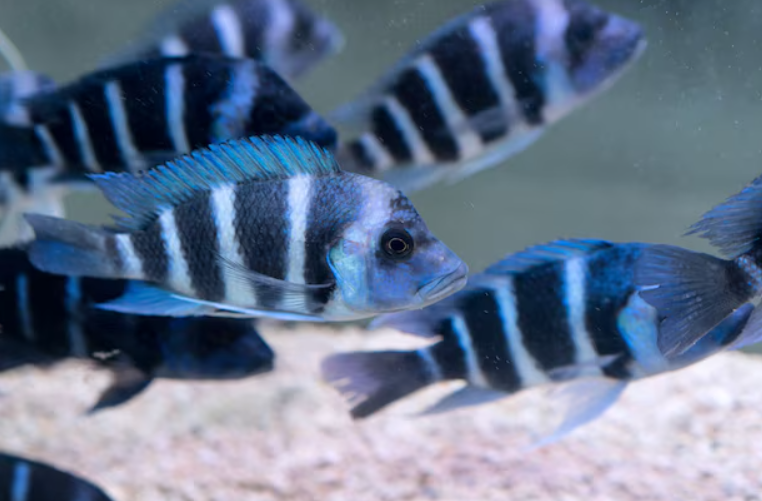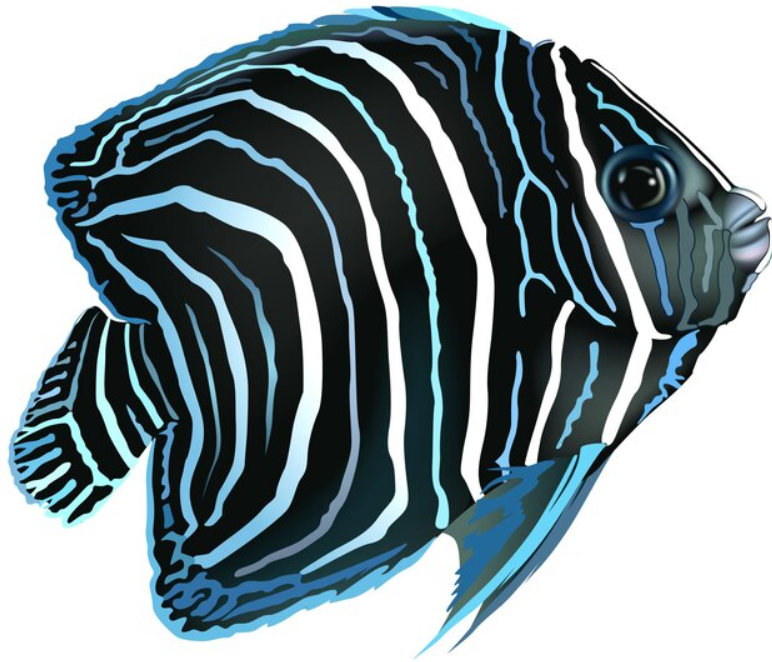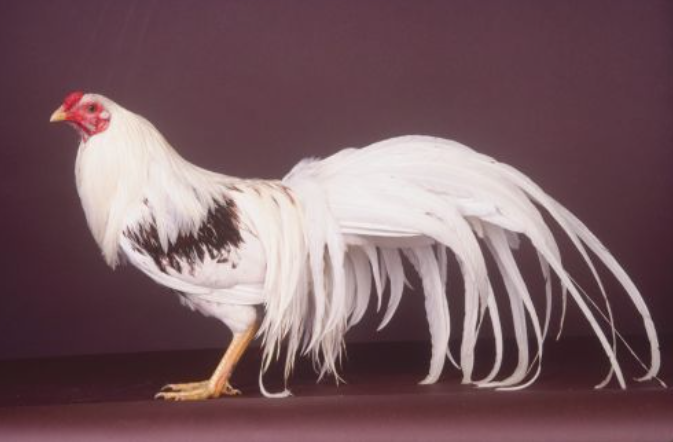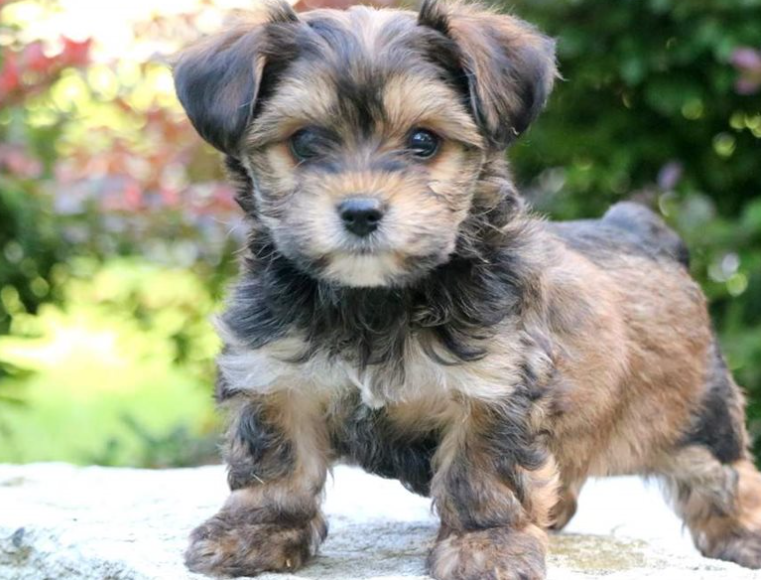
Quick Top 10 Facts about Zebra Pleco
| SCIENTIFIC NAME | Hypancistrus zebra |
| CLASSIFICATION | KINGDOM: Animalia PHYLUM: Chordata CLASS: Actinopterygii ORDER: Siluriformes FAMILY: Loricariidae GENUS: Hypancistrus SPECIES: H. zebra |
| SIZE | Length: 3–4 inches (7.6–10 cm) |
| HABITAT | Native to the Rio Xingu River in Brazil, found in fast-flowing, clear waters with rocky and sandy substrates |
| DIET | Omnivorous; primarily feeds on algae, biofilm, and detritus, but will also eat small invertebrates |
| SPECIES | A rare and sought-after species known for its striking black and white striping pattern, popular among aquarium enthusiasts |
| COUNTRY | Endemic to Brazil, specifically the Rio Xingu basin in the Amazon River system |
| GESTATION PERIOD | Egg-laying species; after fertilization, eggs hatch in about 4–7 days |
| LIFE SPAN | 8–10 years in captivity |
| CONSERVATION STATUS | Endangered; Zebra Plecos are listed as vulnerable due to habitat destruction, water pollution, and overfishing for the aquarium trade |
Amazing Facts About Zebra Plecos
1. Distinctive black and white stripes
Zebra Plecos are known for their striking zebra-like pattern, with bold black and white horizontal stripes across their bodies.
2. Endemic to Brazil
Zebra Plecos are native to the Rio Xingu River in Brazil, where they are found in fast-moving waters with rocky and sandy substrates.
3. Popular aquarium fish
Their striking appearance and small size make them highly prized in the aquarium hobby, though they require specialized care due to their specific habitat needs.
4. Prefer fast-moving water
These fish are adapted to life in clear, oxygen-rich waters and thrive in aquariums with strong water movement, similar to their native river habitats.
5. Omnivorous diet
While primarily feeding on algae and biofilm, Zebra Plecos will also eat small invertebrates and detritus, making them useful for controlling algae growth in aquariums.
6. Rare and endangered
The Zebra Pleco is a rare and endangered species due to overcollection for the aquarium trade and the destruction of its native habitat in Brazil.
7. Requires high water quality
Zebra Plecos are sensitive to water quality, and they require well-filtered, clean, and slightly acidic water for optimal health.
8. Active at night
These fish are primarily nocturnal, feeding and being most active during the evening and nighttime hours.
9. Can live up to 10 years
With proper care, Zebra Plecos can live for up to 10 years, making them a long-term investment for aquarium hobbyists.
10. Conservation efforts
Conservation initiatives are underway to protect the Zebra Pleco’s natural habitat in Brazil, including efforts to regulate the aquarium trade and reduce pollution in the Rio Xingu River.
Zebra Pleco: The Striking and Elusive Freshwater Fish
The zebra pleco (Hypancistrus zebra) is a mesmerizing species of freshwater fish, admired for its bold black-and-white striped pattern and peaceful, bottom-dwelling nature. Native to the Xingu River in Brazil’s Amazon Basin, this fish has become highly prized in the aquarium industry due to its unique appearance and relatively low-maintenance care requirements. However, due to its limited natural range and breeding challenges in captivity, the zebra pleco faces conservation concerns in the wild.
In this article, we will explore the physical traits, habitat, behavior, diet, and conservation status of the zebra pleco. We will also discuss how these fascinating fish are adapted to their native environment and offer guidance for proper care in the aquarium.
What is a Zebra Pleco?
The zebra pleco, scientifically known as Hypancistrus zebra, is a species of armored catfish most easily recognized by its striking black-and-white vertical stripes, which resemble a zebra’s pattern. Unlike other plecos, which are often brown or greenish for camouflage, zebra plecos are distinguished by their contrasting stripes, making them one of the most visually captivating fish in the aquarium world.
Zebra plecos are relatively small, typically growing to around 3 inches (7.5 cm) in length, though some may grow slightly larger. Their eye-catching appearance and bottom-dwelling nature make them an interesting addition to aquariums, though they do require specific conditions to thrive.
Physical Characteristics of Zebra Plecos
The zebra pleco is known for its dramatic appearance, with vertical black-and-white stripes running from head to tail, which are its most defining feature.
Body Shape of Zebra Plecos
Zebra plecos possess a compact, flattened body shape, which helps them cling to rocks and other surfaces in fast-moving water. This body structure is adapted to navigate through swift currents.
Size of Zebra Plecos
Zebra plecos grow to an average length of about 3 inches (7.5 cm), with some individuals reaching slightly larger sizes. Despite their small stature, they are often a highlight in aquariums due to their striking appearance.
Fins and Tail of Zebra Plecos
Their fins are small but well-suited for moving in strong currents. The pectoral fins are broad and spiny, aiding in stability while clinging to substrates, and the tail fin is slightly forked.
Coloration of Zebra Plecos
The zebra pleco’s black-and-white striping makes it stand out from other species. The striking contrast between the black and white, combined with the fish’s small size, makes it one of the most popular catfish species among aquarists.
Mouth and Whiskers of Zebra Plecos
Like other catfish, zebra plecos have a broad mouth and whisker-like barbels that help them sense food and navigate their environment. These barbels are especially useful in the murky waters of the Xingu River.
 Habitat and Natural Distribution of Zebra Plecos
Habitat and Natural Distribution of Zebra Plecos
Native Habitat: The Xingu River
Zebra plecos are endemic to the Xingu River, a major tributary of the Amazon River in Brazil. The river is fast-flowing and clear, with a unique ecosystem. Zebra plecos inhabit rocky areas where the water is well-oxygenated and moves rapidly over large stones and boulders. These regions provide ideal surfaces for resting and feeding.
Water Conditions for Zebra Plecos
The Xingu River has relatively cooler water temperatures compared to other parts of the Amazon, usually ranging from 75°F to 80°F (24°C to 27°C). The water is slightly acidic, with a pH level of around 6.0 to 7.0, which is optimal for zebra plecos.
Aquarium Habitat for Zebra Plecos
To mimic their natural environment, zebra plecos in aquariums need a well-filtered tank with clean, oxygen-rich water. A tank size of at least 30 gallons (114 liters) is recommended to provide them with sufficient space. It’s important to include rocky surfaces, driftwood, and hiding spots to create a suitable habitat.
Bright lighting should be avoided, as zebra plecos prefer dimmer environments in which they feel secure. Proper filtration and stable water quality are essential for their health.
Behavior and Social Structure of Zebra Plecos
Zebra plecos are primarily solitary, often living alone or in pairs. In the wild, they establish territories along the riverbed, where they cling to rocks and crevices to feed and rest. These fish are nocturnal, feeding on small invertebrates and detritus at night.
Territorial Behavior of Zebra Plecos
Zebra plecos are somewhat territorial, particularly when their hiding spots are invaded by other fish. They may exhibit aggression toward other species that encroach on their space, a common behavior among plecos.
Feeding Habits of Zebra Plecos
Zebra plecos are omnivores, feeding on biofilm, algae, and small invertebrates on rocks and surfaces. In aquariums, they should be provided with algae wafers, vegetables like zucchini, and protein sources like bloodworms or brine shrimp.
Nocturnal Behavior of Zebra Plecos
As nocturnal feeders, zebra plecos are most active at night, using their barbels to search for food along the tank’s substrate. During the day, they typically hide in caves or crevices to avoid light.
Diet and Feeding for Zebra Plecos
Zebra plecos are omnivores, eating a variety of plant and animal matter in the wild. Their diet consists of algae, biofilm, and small invertebrates found on rocks and other surfaces.
In captivity, their diet should be supplemented with:
Algae wafers or pellets designed for bottom feeders
Vegetables like blanched zucchini, cucumber, or spinach
Frozen foods such as bloodworms, brine shrimp, or daphnia
Since zebra plecos are nocturnal, it’s best to feed them in the evening or at night, when they are most active.
Reproduction and Breeding of Zebra Plecos
Breeding zebra plecos in captivity is challenging, but it has been successfully accomplished by experienced aquarists. Breeding requires very specific water conditions, closely mimicking their natural habitat.
In the wild, zebra plecos breed during the wet season, when water levels rise. Males build a cave-like nest from available materials and guard it while the female lays her eggs inside. The male fertilizes the eggs and protects them until they hatch.
In aquariums, breeding success requires maintaining stable water conditions, such as soft, slightly acidic water with temperatures between 75°F and 80°F. Adequate hiding spots and proper water flow are also essential for breeding.
Conservation Status and Threats to Zebra Plecos
The zebra pleco is listed as vulnerable by the International Union for Conservation of Nature (IUCN) due to its limited habitat in the Xingu River, which faces threats from habitat destruction and pollution. The construction of dams, particularly the Belo Monte Dam, has severely affected the pleco’s natural environment by altering water flow, temperature, and water quality.
Additionally, the popularity of zebra plecos in the aquarium trade has led to over-collection in the wild. Although captive breeding programs are underway, they haven’t yet met demand, raising concerns about the long-term survival of wild populations.
Conservation of Zebra Plecos
The zebra pleco is a striking and unique species, prized for its bold black-and-white striped appearance and fascinating behavior. Native to the Xingu River in Brazil, this bottom-dwelling fish requires specific environmental conditions to thrive. Despite being a popular aquarium fish, the zebra pleco faces significant conservation challenges due to habitat loss and over-collection.
Aquarium owners should ensure they provide suitable care, including proper water conditions, hiding spots, and a varied diet. Additionally, efforts to protect the zebra pleco’s natural habitat are essential for preserving this remarkable species for future generations.
FAQ (Frequently Asked Questions) about Zebra Pleco
Q: What is a Zebra Pleco?
Ans: The Zebra Pleco (Hypancistrus zebra) is a small, strikingly patterned freshwater fish native to the Xingu River in Brazil. It is known for its bold black and white striped pattern, resembling the stripes of a zebra, which is how it got its name. Zebra Plecos are popular in the aquarium hobby due to their unique appearance and peaceful nature.
Q: What do Zebra Plecos look like?
Ans: Zebra Plecos have a distinctive black and white striped pattern along their bodies. Their body is generally flat and broad, with large pectoral fins and a sucker-like mouth that helps them cling to rocks and surfaces. The coloration on their body helps them blend into their natural environment, which is often rocky and fast-flowing rivers.
Q: How big do Zebra Plecos grow?
Ans: Zebra Plecos are small fish, with adults typically growing to about 3 to 4 inches (7.5 to 10 cm) in length. Their small size makes them suitable for medium to large aquariums, and they are ideal for aquarists who prefer smaller, peaceful fish species.
Q: What do Zebra Plecos eat?
Ans: Zebra Plecos are primarily carnivorous, feeding mainly on algae, biofilm, and small invertebrates that grow on rocks and surfaces in their natural habitat. In captivity, they are often fed sinking algae wafers, specialized pleco food, and occasional protein-rich foods such as brine shrimp and bloodworms.
Q: Are Zebra Plecos easy to care for?
Ans: Zebra Plecos are not particularly difficult to care for but require specific conditions to thrive. They prefer well-maintained aquariums with strong filtration and stable water parameters. Maintaining clean, oxygen-rich water with a temperature range of 78-82°F (25-28°C) and a slightly acidic to neutral pH is important for their health. They are also nocturnal and may be more active at night.
Q: How long do Zebra Plecos live?
Ans: Zebra Plecos typically live for 10 to 15 years when provided with proper care in a well-maintained aquarium. Their longevity can be influenced by water quality, diet, and overall tank environment.
Q: Can Zebra Plecos be kept with other fish?
Ans: Yes, Zebra Plecos are peaceful and can be kept with other peaceful fish species in a community tank. However, they should not be kept with overly aggressive fish or species that may compete for food. They do well in tanks with other small, non-aggressive fish like tetras, catfish, and shrimp.
Q: What type of aquarium setup is best for Zebra Plecos?
Ans: Zebra Plecos thrive in aquariums that mimic their natural riverine habitat. They prefer tanks with plenty of hiding spots, such as caves, driftwood, and rocks, where they can feel secure. A well-maintained filter system is important to keep the water clean and oxygenated. It’s also essential to maintain a stable water temperature and provide good water circulation.
Q: Are Zebra Plecos endangered?
Ans: Yes, Zebra Plecos are considered endangered due to habitat destruction, overcollection, and pollution in their native waters. They are listed in the Convention on International Trade in Endangered Species (CITES) Appendix II, which means they are protected by international trade regulations to prevent over-exploitation.
Q: Where can I find Zebra Plecos for sale?
Ans: Zebra Plecos are rare and expensive, so they are not commonly found in most pet stores. They are usually available through specialized aquarium shops or online retailers. It’s important to ensure that any Zebra Pleco purchased comes from a responsible breeder or importer to ensure the fish was sourced legally and sustainably.
#ZebraPleco, #PlecoFish, #FreshwaterFish, #AquariumFish, #RareFish, #EndangeredFish, #Fishkeeping, #AquariumCare, #FishConservation, #ExoticFish, #AquaticLife
Our sources and references about Zebra Pleco
1: Wikipedia – Zebra Pleco
2: Aquatic Community – Zebra Pleco Care
3: Fishkeeping World – Zebra Pleco
4: PetMD – Zebra Pleco Care



